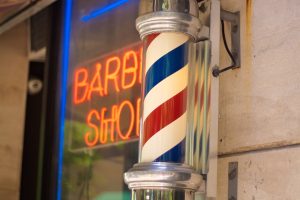Unraveling the Barber Pole: Its Rich History & Color Significance in Barbering
The Fascinating History of the Barber Pole and the Significance of its Colors
Barbershops are a fixture in communities worldwide. While the tools, techniques, and trends have evolved, one symbol remains deeply rooted in the identity of the barbering profession: the barber pole. This seemingly simple symbol, typically characterized by its spiraling red, white, and blue colors, holds a rich and intriguing history that dates back to the Middle Ages.
The Birth of the Barber Pole: Medieval Times
To understand the origins of the barber pole, we need to journey back to a time when barbers did more than just cut hair. During the Middle Ages in Europe, barbers often performed surgical procedures, a task that might seem unimaginable today. They were commonly known as “barber-surgeons.”
The services provided by these barber-surgeons varied from tooth extractions to bloodletting – a once-popular belief that draining “bad blood” could cure ailments. For bloodletting, barbers would use leeches or make incisions. Patients would grip a rod or a pole during the procedure, which would encourage blood flow.
After the procedure, the stained bandages, showcasing red (blood) and white (bandages), were washed and hung to dry on the pole outside the shop. Over time, this became an advertising strategy, informing potential clients of the services offered within.
Transition to Modern Barbering and the Incorporation of Blue
As time progressed, the medical community began to separate from the barbering profession, leading to distinct roles: physicians who dealt with internal ailments and surgeons who dealt with external traumas and issues. Eventually, the British Parliament passed an act in 1745 that officially distanced surgeons from barbers. However, the association between barbers and their historical surgical role persisted, symbolized by the barber pole.
While red and white were the original colors, blue was added in the United States. There are various theories regarding the incorporation of blue. Some believe it was an homage to the national colors of the U.S. (red, white, and blue). Others postulate that the blue might represent venous blood, contrasting the red’s representation of arterial blood.
Symbolic Interpretations

A photo showcasing the historical evolution of barbershop entrance designs
- Red: As mentioned, the red traditionally symbolizes blood. This serves as a reminder of the barber-surgeon’s role in bloodletting and other surgical procedures.
- White: The white stripe, historically, represents the bandages used during surgical procedures, both as a tool and post-operation.
- Blue: While its origins are debated, the blue is thought to represent venous blood or simply be an American adaptation to align with national colors.
A Timeless Emblem in Modern Barbering
Today, while barbers no longer perform medical procedures, the barber pole remains an iconic symbol of the profession. It’s a nod to the rich history and the evolution of the trade. The pole stands as a beacon, signifying trust, tradition, and the timeless craft of barbering.
In essence, the barber pole is not just a decorative piece or mere advertisement; it’s a testament to the resilience and transformation of the barbering profession, reminding us of the intricate tapestry of history, service, and community that barbershops have woven over centuries.
Related Posts
The Enduring Strength of Barbering as a Career Choice
In an ever-changing economic landscape, the barbering profession stands out for its resilience and enduring appeal. This stability is rooted in the essential nature of the services barbers provide, transcending mere fashion or luxury to become a staple of personal maintenance and social interaction. A Tradition of Trust and Loyalty At the heart of barberingR
Inside the Barbershop: A Unique Culture Known Only to Those Who Wield the Scissors
The world of barbering is rich with tradition and camaraderie, a unique culture that can only be fully understood by those who work within its confines. To outsiders, a barbershop may simply appear as a place to get a haircut or a shave, but for those who hold the clippers and razors, it represents a […]
Barbers and the White House: How Barbers Play a Vital Role in U.S. Politics
From grooming military generals to styling political leaders, barbers have long held a special place in American history. Though they may not appear on the political stage, barbers play an essential, behind-the-scenes role in the lives of some of the most powerful individuals in the United States. The White House, the center of American government, […]
The Timeless Tools of Barbering: A Look at Historical Instruments Still in Use Today
The art of barbering is as old as civilization itself, with a rich history that spans thousands of years. Over time, the tools of the trade have evolved, yet many have remained remarkably consistent in their form and function. This blog post delves into the fascinating history of barbering tools and explores how some of […]




